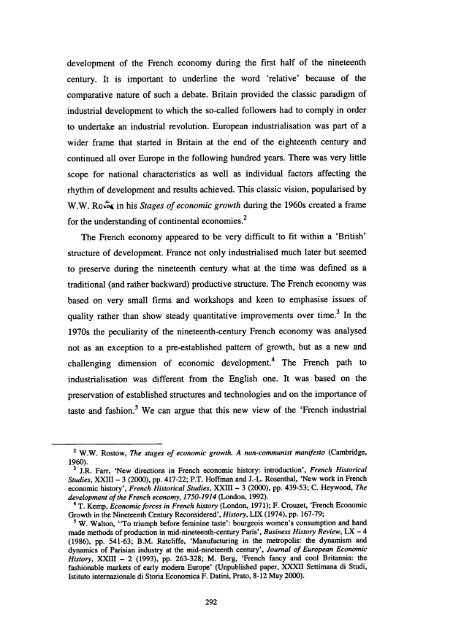The Boot and Shoe Trades in London and Paris in the Long Eighteenth Century
The Boot and Shoe Trades in London and Paris in the Long Eighteenth Century
The Boot and Shoe Trades in London and Paris in the Long Eighteenth Century
You also want an ePaper? Increase the reach of your titles
YUMPU automatically turns print PDFs into web optimized ePapers that Google loves.
development of <strong>the</strong> French economy dur<strong>in</strong>g <strong>the</strong> first half of <strong>the</strong> n<strong>in</strong>eteenth<br />
century. It is important to underl<strong>in</strong>e <strong>the</strong> word 'relative' because of <strong>the</strong><br />
comparative nature of such a debate. Brita<strong>in</strong> provided <strong>the</strong> classic paradigm of<br />
<strong>in</strong>dustrial development to which <strong>the</strong> so-called followers had to comply <strong>in</strong> order<br />
to undertake an <strong>in</strong>dustrial revolution. European <strong>in</strong>dustrialisation was part of a<br />
wider frame that started <strong>in</strong> Brita<strong>in</strong> at <strong>the</strong> end of <strong>the</strong> eighteenth century <strong>and</strong><br />
cont<strong>in</strong>ued all over Europe <strong>in</strong> <strong>the</strong> follow<strong>in</strong>g hundred years. <strong>The</strong>re was very little<br />
scope for national characteristics as well as <strong>in</strong>dividual factors affect<strong>in</strong>g <strong>the</strong><br />
rhythm of development <strong>and</strong> results achieved. This classic vision, popularised by<br />
W.W. Ro <strong>in</strong> his Stages of economic growth dur<strong>in</strong>g <strong>the</strong> 1960s created a frame<br />
for <strong>the</strong> underst<strong>and</strong><strong>in</strong>g of cont<strong>in</strong>ental economies.2<br />
<strong>The</strong> French economy appeared to be very difficult to fit with<strong>in</strong> a 'British'<br />
structure of development. France not only <strong>in</strong>dustrialised much later but seemed<br />
to preserve dur<strong>in</strong>g <strong>the</strong> n<strong>in</strong>eteenth century what at <strong>the</strong> time was def<strong>in</strong>ed as a<br />
traditional (<strong>and</strong> ra<strong>the</strong>r backward) productive structure. <strong>The</strong> French economy was<br />
based on very small firms <strong>and</strong> workshops <strong>and</strong> keen to emphasise issues of<br />
quality ra<strong>the</strong>r than show steady quantitative improvements over time. 3 In <strong>the</strong><br />
1970s <strong>the</strong> peculiarity of <strong>the</strong> n<strong>in</strong>eteenth-century French economy was analysed<br />
not as an exception to a pre-established pattern of growth, but as a new <strong>and</strong><br />
challeng<strong>in</strong>g dimension of economic development.4 <strong>The</strong> French path to<br />
<strong>in</strong>dustrialisation was different from <strong>the</strong> English one. It was based on <strong>the</strong><br />
preservation of established structures <strong>and</strong> technologies <strong>and</strong> on <strong>the</strong> importance of<br />
taste <strong>and</strong> fashion. 5 We can argue that this new view of <strong>the</strong> 'French <strong>in</strong>dustrial<br />
2<br />
W.W. Rostow, <strong>The</strong> stages of economic growth. A non-communist manifesto (Cambridge,<br />
1960).<br />
JR. Farr, 'New directions <strong>in</strong> French economic history: <strong>in</strong>troduction', French Historical<br />
Studies, XXIII - 3 (2000), pp. 417-22; P.T. Hoffman <strong>and</strong> J.-L. Rosenthal, 'New work <strong>in</strong> French<br />
economic history', French Historical Studies, XXIII - 3 (2000), pp. 439-53; C. Heywood, <strong>The</strong><br />
development of <strong>the</strong> French economy, 1750-1914 (<strong>London</strong>, 1992).<br />
' T. Kemp, Economic forces <strong>in</strong> French history (<strong>London</strong>, 1971); F. Crouzet, 'French Economic<br />
Growth <strong>in</strong> <strong>the</strong> N<strong>in</strong>eteenth <strong>Century</strong> Reconsidered', History, LIX (1974), pp. 167-79;<br />
W. Walton, "To triumph before fem<strong>in</strong><strong>in</strong>e taste': bourgeois women's consumption <strong>and</strong> h<strong>and</strong><br />
made methods of production <strong>in</strong> mid-n<strong>in</strong>eteenth-century <strong>Paris</strong>', Bus<strong>in</strong>ess History Review, LX —4<br />
(1986), pp. 541-63; B.M. Ratcliffe, 'Manufactur<strong>in</strong>g <strong>in</strong> <strong>the</strong> metropolis: <strong>the</strong> dynamism <strong>and</strong><br />
dynamics of <strong>Paris</strong>ian <strong>in</strong>dustry at <strong>the</strong> mid-n<strong>in</strong>eteenth century', Journal of European Economic<br />
History, XXIII - 2 (1993), pp. 263-328; M. Berg, 'French fancy <strong>and</strong> cool Britannia: <strong>the</strong><br />
fashionable markets of early modern Europe' (Unpublished paper, XXXII Settimana di Studi,<br />
Istituto <strong>in</strong>ternazionale di Storia Economica F. Dat<strong>in</strong>i, Prato, 8-12 May 2000).<br />
292


